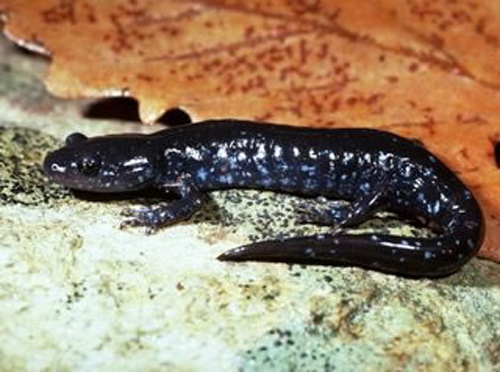The Blue-spotted Salamander is a member of the mole salamander family, so named because the members of this family spend most of their lives underground. Blue-spotted salamanders are smooth-skinned and black with blue spots or flecks. They can be up to 8 inches long.
The blue-spotted salamander interbreeds frequently with another Connecticut salamander species, the jefferson's salamander. These two species have so thoroughly interbred that there are almost no pure populations of either found here. It is very difficult to tell one from the other and from hybrids without genetic tests.
The blue-spotted salamander can also interbreed with spotted salamanders.
The range of blue-spotted salamanders is along the Atlantic coast from New Jersey to Quebec, and in the Great Lakes region. Blue-spotted salamanders are found throughout Connecticut, but are not near the coast. They are rare; more rare than the jefferson's salamanders with which they often interbreed. The many hybrids of blue-spotted and jefferson's salamanders are considered species of Special Concern in Connecticut. The limited populations of pure blue-spotted salamanders are considered Threatened in the state.
Adult blue-spotted salamanders spend most of their lives in burrows under leaf litter, rotting logs or deeper underground. They prefer damp areas, usually forested. They hibernate over the winter in burrows or tunnels.
Mating season occurs in March. Males and females emerge from their burrows and head to water to mate. Blue-spotted salamanders use temporary vernal pools which are safer for eggs and young as they are fish-free. They will also use other wet areas, such as red maple swamps, which are not typically fish-free. During breeding males deposit packets of sperm in the water. Females pick up these packets through their cloaca, the opening amphibians use for breeding, egg-laying and waste. Fertilization of her eggs takes place internally. The female will lay eggs either individually or in 10 to 20 small bunches of about 15 each on the bottom of the vernal pool. They hatch into larvae in 30 to 45 days.
The larval stage for these salamander is aquatic and they have gills. They live in the water while they develop into adults and have usually metamorphosized into the adult stage by September when the adults leave the water and begin their terrestial life of burrowing.
Adult blue-spotted salamanders eat insects and invertebrates, as do their larvae.
A threatened blue-spotted salamander will thrash its tail and exude a noxious substance from two glands by its tail. If its tail is grabbed, it will fall off and continue to thrash. This releases the salamander for escape, and hopefully the thrashing tail will distract the predator. They will regrow their lost tail.
